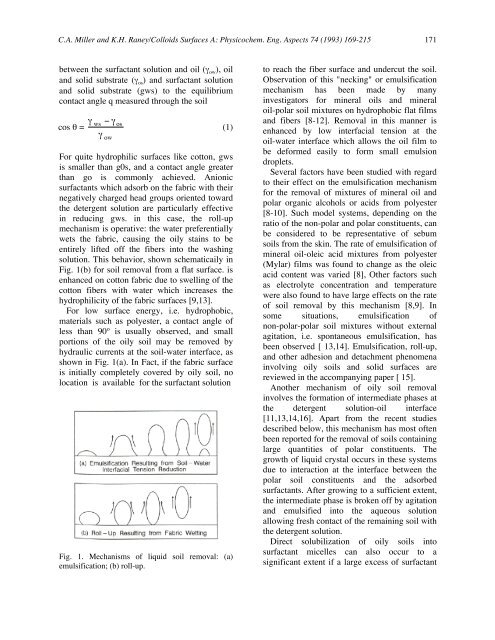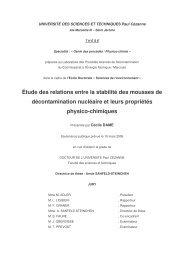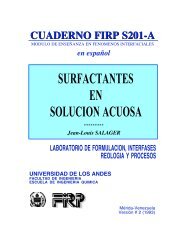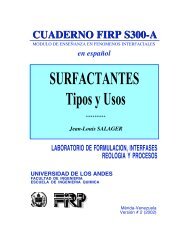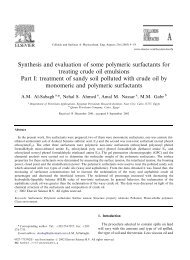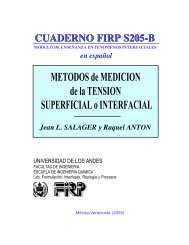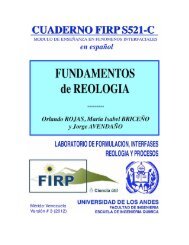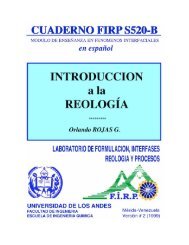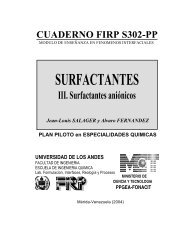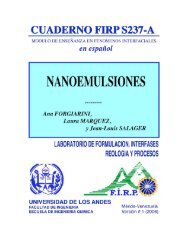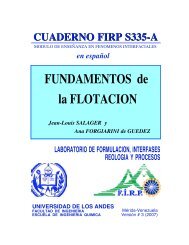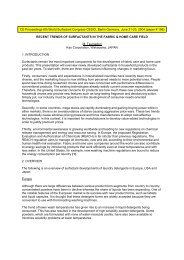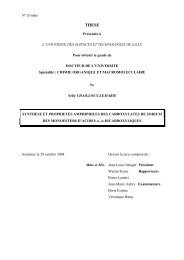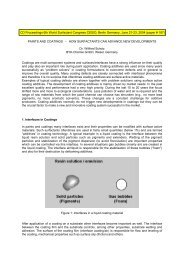Solubilization-emulsification mechanisms of detergency
Solubilization-emulsification mechanisms of detergency
Solubilization-emulsification mechanisms of detergency
Create successful ePaper yourself
Turn your PDF publications into a flip-book with our unique Google optimized e-Paper software.
C.A. Miller and K.H. Raney/Colloids Surfaces A: Physicochem. Eng. Aspects 74 (1993) 169-215 171<br />
between the surfactant solution and oil (γ ow), oil<br />
and solid substrate (γ os) and surfactant solution<br />
and solid substrate (gws) to the equilibrium<br />
contact angle q measured through the soil<br />
cos θ = γ ws − γ os<br />
γ ow<br />
(1)<br />
For quite hydrophilic surfaces like cotton, gws<br />
is smaller than g0s, and a contact angle greater<br />
than go is commonly achieved. Anionic<br />
surfactants which adsorb on the fabric with their<br />
negatively charged head groups oriented toward<br />
the detergent solution are particularly effective<br />
in reducing gws. in this case, the roll-up<br />
mechanism is operative: the water preferentially<br />
wets the fabric, causing the oily stains to be<br />
entirely lifted <strong>of</strong>f the fibers into the washing<br />
solution. This behavior, shown schematicaily in<br />
Fig. 1(b) for soil removal from a flat surface. is<br />
enhanced on cotton fabric due to swelling <strong>of</strong> the<br />
cotton fibers with water which increases the<br />
hydrophilicity <strong>of</strong> the fabric surfaces [9,13].<br />
For low surface energy, i.e. hydrophobic,<br />
materials such as polyester, a contact angle <strong>of</strong><br />
less than 90º is usually observed, and small<br />
portions <strong>of</strong> the oily soil may be removed by<br />
hydraulic currents at the soil-water interface, as<br />
shown in Fig. 1(a). In Fact, if the fabric surface<br />
is initially completely covered by oily soil, no<br />
location is available for the surfactant solution<br />
Fig. 1. Mechanisms <strong>of</strong> liquid soil removal: (a)<br />
<strong>emulsification</strong>; (b) roll-up.<br />
to reach the fiber surface and undercut the soil.<br />
Observation <strong>of</strong> this "necking" or <strong>emulsification</strong><br />
mechanism has been made by many<br />
investigators for mineral oils and mineral<br />
oil-polar soil mixtures on hydrophobic flat films<br />
and fibers [8-12]. Removal in this manner is<br />
enhanced by low interfacial tension at the<br />
oil-water interface which allows the oil film to<br />
be deformed easily to form small emulsion<br />
droplets.<br />
Several factors have been studied with regard<br />
to their effect on the <strong>emulsification</strong> mechanism<br />
for the removal <strong>of</strong> mixtures <strong>of</strong> mineral oil and<br />
polar organic alcohols or acids from polyester<br />
[8-10]. Such model systems, depending on the<br />
ratio <strong>of</strong> the non-polar and polar constituents, can<br />
be considered to be representative <strong>of</strong> sebum<br />
soils from the skin. The rate <strong>of</strong> <strong>emulsification</strong> <strong>of</strong><br />
mineral oil-oleic acid mixtures from polyester<br />
(Mylar) films was found to change as the oleic<br />
acid content was varied [8], Other factors such<br />
as electrolyte concentration and temperature<br />
were also found to have large effects on the rate<br />
<strong>of</strong> soil removal by this mechanism [8,9]. In<br />
some situations, <strong>emulsification</strong> <strong>of</strong><br />
non-polar-polar soil mixtures without external<br />
agitation, i.e. spontaneous <strong>emulsification</strong>, has<br />
been observed [ 13,14]. Emulsification, roll-up,<br />
and other adhesion and detachment phenomena<br />
involving oily soils and solid surfaces are<br />
reviewed in the accompanying paper [ 15].<br />
Another mechanism <strong>of</strong> oily soil removal<br />
involves the formation <strong>of</strong> intermediate phases at<br />
the detergent solution-oil interface<br />
[11,13,14,16]. Apart from the recent studies<br />
described below, this mechanism has most <strong>of</strong>ten<br />
been reported for the removal <strong>of</strong> soils containing<br />
large quantities <strong>of</strong> polar constituents. The<br />
growth <strong>of</strong> liquid crystal occurs in these systems<br />
due to interaction at the interface between the<br />
polar soil constituents and the adsorbed<br />
surfactants. After growing to a sufficient extent,<br />
the intermediate phase is broken <strong>of</strong>f by agitation<br />
and emulsified into the aqueous solution<br />
allowing fresh contact <strong>of</strong> the remaining soil with<br />
the detergent solution.<br />
Direct solubilization <strong>of</strong> oily soils into<br />
surfactant micelles can also occur to a<br />
significant extent if a large excess <strong>of</strong> surfactant


